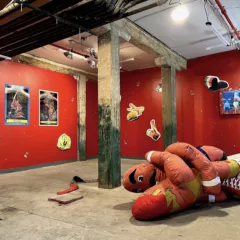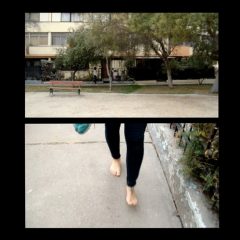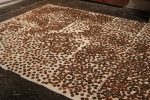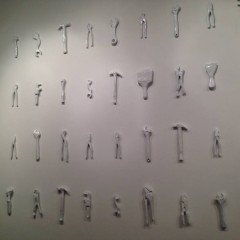A visit to Fjord this March was a journey down from the “Ivory Tower.” The show was thus named because of the term’s connotation with a supposed pristine, sterile, and luxurious way of life which the curators Kaitlynd O’Doherty and Sarah Pater sought to topple or at least dissect. Ten artists provided the work which ranged in medium from video, to installation, to polystyrene and even pudding. The show closed on Saturday. Here’s a peek at what was there.
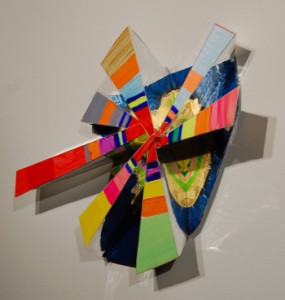
Directly next to the doorway, a shiny contraption attracts visitors’ attention, hooking them into the show with its unique, mirrored madness. Part wheel, part looking glass, Tamara Zahaykevich’s “Coocooriku” is as eye-catching as it is deceptive. The spoke-like central forms extend in a vaguely radial pattern and reflect in the silvery mylar backing, adding to the illusion of pinwheel-like movement or warped repetition. It has little basis in any other recognizable images, but its bright colors and sheen relate it to precious stones, metals, or amulets. Surely those peering down from their affluence would fawn over such extravagance, but in this case, the product is merely foam and acrylic paint – costume jewelry for an indebted leisure class.
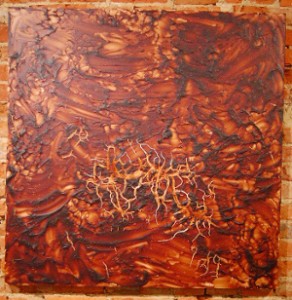
Even more basic, and certainly less shiny, is Will Haughery’s “Stick in the Mud.” This canvas is a scabby, smeared expression utilizing the unlikely material of pudding (presumably chocolate, based on the not-quite-lovely shades of brown). While in some ways revolting, the texturing in this piece was done quite deliberately, and the lower third includes an electric, fractal pattern that one would expect to see in the dried, cracked mud surfaces that it represents. It is also a reminder that, even where towers are the tallest and boldest, their foundations still rest in the same earth that lies beneath us; eventually all of us, and all of our grandiose achievements, will retreat back to whence they came.
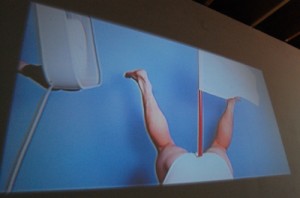
Two pieces reside in Fjord’s back room. One, a video entitled “Surrender” by Kris Harzinski and Will Haughery, provides wordless commentary on the act of raising the white flag, which in many ways seems the antithesis of penthouses in white towers. Surrender is often considered cowardly, and oftentimes the last resort; it is anything but ideal. Any of these considerations is essentially smashed to bits when watching this video, however, it offers mostly physical comedy in place of thoughtful introspection. The action begins with a white, underwear-wearing posterior facing skyward, legs spread just a bit. An anonymous, gloved hand enters the frame, and with a kitchen knife, slits a hole in the underwear. The masked figured proceeds to mount an orange pole topped with a white cloth into the also anonymous rectum, then retrieves an electric fan which, when turned on, unfurls the flag for the world to see. If nothing else, this hilariously submissive video demonstrates the ultimate form of surrender.
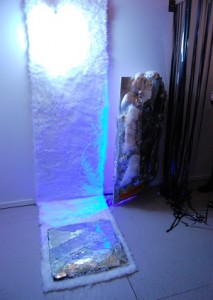
Anne Vieux’s neighboring installation entitled “Slit Slat” provides a slightly more cynical and cinematic take on things. A tall floor-to-ceiling lining of white fur provides a skyscraper-like outline for a tower which is less ivory and more polar bear pelt. At the base rests a mirror, shattered and fractured, but mostly retaining its original square form. Directly adjacent to the non-structure is a mess of unwound VHS tape, perhaps lamenting the death of a longstanding analog tradition in favor of the digital. And it is not a stretch to say that the mangled wreckage at the bottom is not all too dissimilar from the scars left behind from two fallen towers that we are all more than familiar with. Thanks to the media and the emerging technologies taking off at the time that they crumbled, the world had the displeasure of seeing the pair of buildings collapse time and time and time again.
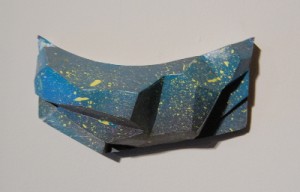
Tamara Zahaykevich’s humble but handsome “Kathy” rounds out a show of antitheses and challenges. It seems like a standout because of its smooth, rigid form and spattered, stylized finish. This chunk of polystyrene and paper provides just the right amount of structure in an otherwise freewheeling exhibit. The speckled paint job is reminiscent of retro airbrush artwork and something from a Nickelodeon gameshow, but it has a strange poise to it as well. Its angular forms are rigid and precise, owing to its relative uniqueness in a mostly chaotic spread of work. If “Ivory Tower” has a foundation, this is it.


